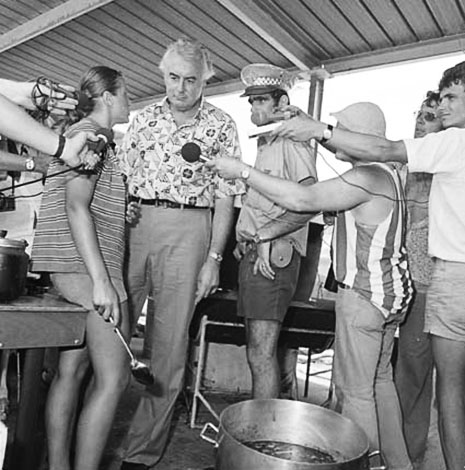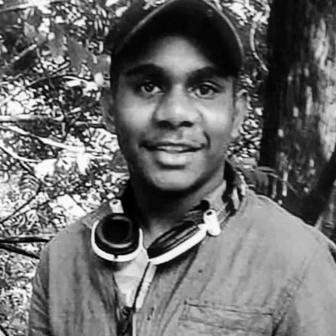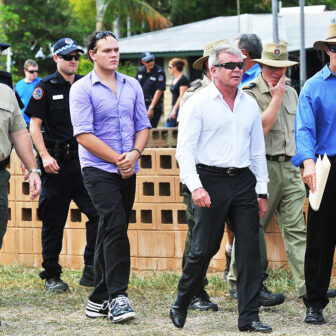ON 1 DECEMBER 1974, about 350 kilometres north-west of Darwin in the Timor Sea, a low pressure system developed into Tropical Cyclone Selma. Selma moved directly towards Darwin and two days later was only 100 kilometres away. The Bureau of Meteorology issued a steady stream of alerts, warning the people of Darwin to prepare for a potentially devastating storm. But at 10 o’clock on the morning of 3 December, Selma changed direction, swinging north and then west away from the city. There had been a lot of rain and some trees had been brought down, but nothing too alarming.
It is a common pattern in disasters: the near miss that causes complacency. When authorities warn of a serious danger that does not eventuate, people can become fatally sceptical. One Darwin resident recalled an early conversation about whether Tracy was a real threat: “We had had Cyclone Selma only a few weeks before… Everyone was sick of talking about cyclones – and besides, Christmas was here.”
On 21 December, a large cloud mass that had been forming in the Arafura Sea, some 700 kilometres to the north-east of Darwin, began to revolve and the winds at its centre reached high velocities. At 10 o’clock in the evening the system started to move and it was officially designated a tropical cyclone, and given the name Tracy.
At Christmas Eve parties, the consensus was that Tracy would do what Selma had done on approaching Darwin, what every cyclone for decades had done: veer away. The police were in touch with the Weather Bureau and had followed standard procedures to prepare for an emergency. But no one was really worried. “It was still being taken lightly,” one officer recalled. “It was ‘just another blow’.”
By noon on 24 December, the picture was clearer, and alarming. Tracy was 110 kilometres north-west of Darwin and was headed south-east – straight for the city. The winds inside the storm were extreme. At 12.30 p.m. the Tropical Cyclone Warning Centre issued a formal alert:
VERY DESTRUCTIVE WINDS OF 120 KILOMETRES PER HOUR WITH GUSTS TO 150 KILOMETRES PER HOUR HAVE BEEN REPORTED NEAR THE CENTRE AND ARE EXPECTED IN THE DARWIN AREA TONIGHT AND TOMORROW.
Some people took precautions: putting masking tape on windows, tying down loose objects, checking that they had a battery torch and radio in case the power went out. Others attended Christmas parties, got drunk, and went to bed. What then unfolded was a slow-building nightmare. As evening drew into night, power was lost, the wind rose, and kept rising, and the torrential rain forced its way into houses. At first, people tried to protect carpets and valuables, but such thoughts were soon forgotten as the magnitude of the storm became apparent. Glass louvres bowed with the pressure of the wind, and began to explode. Many windows were ripped – frame and all – from the walls. Most families retreated to the bathroom – by conventional wisdom and official advice, the strongest and safest room in the house.
After midnight, the full fury of the leading edge of the cyclone struck. The wind reached speeds in excess of 150 kilometres per hour. Many houses lost their roofs, either as cladding was peeled up then whipped away, or with the whole roof suddenly being lifted and swept into the darkness. With the torrential rain now soaking internal partitions, and the structure of houses weakened, walls collapsed or were blown away. Debris – and this included objects as big as refrigerators – hurtled through the air, shattering houses downwind, causing more debris and a chain of destruction.
At about 3 o’clock in the morning the eye of the cyclone passed over Darwin, bringing an eerie stillness. There was a strange light, a diffuse lightening, like St Elmo’s fire. In the quiet, people could hear injured neighbours screaming.
Some houses, more protected than others, had survived the first wind. But everyone knew that this was only a brief lull. When the eye of a cyclone has passed over, the “second wind” comes. It is often more destructive than the first because it comes from the opposite direction, is often stronger, and arrives abruptly. This was the case with Tracy: the first wind had built up over a period of more than an hour, but the second wind arrived like an express train, all the more shocking after the relative silence of the eye. Gusts of well over 200 kilometres an hour filled the air with debris, and blasted already damaged houses apart – in some cases the walls, the collapsed ceilings, every piece of furniture were swept away. Families were left clinging to whatever wreckage remained.
Adding to their misery was the intense cold, as everything was saturated by driving rain and chilled by the gale. The bare floor of a house bucking in the storm on its poles came to be known as a “dance floor” among survivors. Some people tried to crawl downstairs, but there was really nowhere to go. Few houses had a cyclone shelter, and laundry blocks and sheds were often made of light concrete bricks: the walls were not reinforced and bowed in the wind. Many people ended up sheltering in their cars. This was dangerous, but where else were they to go?
Around seventy people died. Hundreds were seriously injured. Of the thousands who survived, almost everyone was wet and cold and often in pain from cuts, lacerations and broken bones. At about 6.30 am, after the storm had faded to a drizzling rain, a grey dawn broke over Darwin. The light revealed a scene of utter devastation. Gary MacKay, an army officer who was part of the relief effort and later wrote a history of the disaster, described the damage as “almost obscene in its totality.” Some observers compared the sight to Hiroshima in the wake of the atomic bomb. One was more prosaic: “Darwin was a 250-square-mile-rubbish dump.”
Engineers are generally careful writers and not prone to exaggeration. George Walker was commissioned to report on Cyclone Tracy’s impact on buildings. “The destruction caused in Darwin by Cyclone Tracy”, he wrote, “was the worst suffered by an Australian city in any disaster.”
By Christmas morning, Darwin had, in material terms, almost ceased to exist. For many hours the city was completely isolated from the outside world: every telephone line was cut, every radio transmitter out of action. Tracy destroyed almost every house and block of flats. It seriously damaged almost every public building: schools, hospitals, churches, office blocks and large hotels. By one estimate, of the city’s 13,000 dwellings, only 400 had survived intact.
The city’s vital infrastructure was destroyed or immobilised. Every roadway was blocked, the airport runway was unusable, the port’s wharves wrecked. The power distribution network, most of it comprising overhead powerlines, had been demolished – the power station was badly damaged, its generators stood idle. The water supply and sewerage system both relied on electric pumps, so these also ceased to function. With no sanitation, and so few habitable buildings, there was a danger of diseases such as typhoid. The hospital quickly ran out of basic supplies like local anaesthetic, which was badly needed as so many people had cuts that required stitches. There was water damage through out the hospital, and in the treatment wards the floors ran red with blood.
Making matters worse for the people of Darwin, although the rest of the country responded with great generosity to the disaster, much of the assistance given was ill-considered, poorly organised and of little use. The civil authorities were astonished and dismayed when planes arrived in the sweltering tropical city loaded with blankets. Alan Reiher, a public servant with the Board of Works who played a major role in the relief effort, later said that “most of the things which came in during the first few days (except food and medical supplies) were not wanted.”
It quickly became obvious that the city would have to be almost entirely evacuated. All “non-essential people” were airlifted out. The mass evacuation of some 20,000 people, and their temporary accommodation in military barracks, migrant hostels and private homes across the country, was a vast undertaking.
THE DEVASTATION of Darwin was so great that the federal government seriously considered abandoning the city altogether and rebuilding somewhere else. Katherine was one possibility. As it was, a reconstruction commission was created and a new city arose. Despite the bitter wrangling over what form the fifth “new Darwin” should take, the reconstruction is now generally remembered as a success.
“Darwin is one of the great cities of Australia,” said Rex Patterson, then Minister for the Northern Territory, on the thirtieth anniversary of Tracy. “It proved that the decision to rebuild Darwin was a good one.” Marshall Perron, a Northern Territory politician who later served as chief minister, said that the disaster also provided opportunity: “Lots of dead wood was blown away, and this allowed a fresh start.”
Tracy is sometimes seen as having been the catalyst for the Northern Territory achieving self-government, and for a more permanent and settled community. Another chief minister, Clare Martin, exemplified this cheery view in 2004, when she wrote: “In many ways Tracy transformed Darwin from an isolated tropical outpost, operated by a legion of Commonwealth public servants, to a modern tropical city determined to become Australia’s Gateway to Asia.”
Certainly comments like these put a gloss on the human suffering created by the disaster, and its long-term economic and social cost. It also avoids the sober truth: old Darwin should have survived Tracy more or less intact. It would have done so if the sensible warnings of intelligent and responsible people had been heeded.
Tracy was a cyclone of immense destructive power, but in no way can it be seen as a freak event. That a severe cyclone would again hit Darwin was certain; the only question was when. Yet the city, in its physical and social structures, was appallingly ill-prepared. According to George Walker’s report, large buildings, which were required to be certified for structural strength by engineers, survived the storm “reasonably well.” Smaller buildings, which included almost every house in Darwin, “performed extremely badly.” Perhaps 60 per cent of houses were damaged beyond repair “and in some of the northern suburbs the destruction was nearly 100 per cent.”
In some cases window frames had not been fixed to the surrounding walls – they were just “sitting there,” providing no structural strength at all. But even when basic workmanship was adequate, the house designs were not. At that time, the standards required for houses built in tropical areas did provide for higher wind velocities, but were otherwise much the same as those for non-tropical areas. Walker argued that, had buildings been properly engineered, a cyclone of Tracy’s magnitude still would have caused significant damage, but would have destroyed less than 5 per cent of the houses – still a disaster, but on a far smaller scale. Fewer people would have died or been left homeless. More of the city’s basic infrastructure would have remained intact. The added trauma of mass evacuation might have been avoided.
The things that should have been done, but were not, were basic. Three years before Tracy, in December 1971, Cyclone Althea had hit Townsville, causing significant damage. Drawing on this experience, the Department of Works in Darwin had recommended extra strengthening of houses, that cladding be better secured, and that windows be protected with shutters and screens. But no one paid much attention.
The main reason was complacency. As Alan Reiher recalled, “No one in Darwin believed it could happen to them. No one as far as we could find had experienced a severe cyclone in Darwin before.”
The cost of the relief operation and the reconstruction of Darwin was immense. Estimates vary from $600 million to more than $1 billion. Such a massive diversion of resources was a major setback in the development of basic infrastructure in other parts of the Northern Territory. The “modern tropical city” of Darwin sucked badly needed resources from Katherine, Alice Springs and many remote communities. Even on a national basis, the reconstruction of Darwin cut into resources for development: $1 billion paid for a lot of roads, schools and hospitals in 1975.
In one important respect, though, Tracy did change Australia for the better. In wiping Darwin off the map, the cyclone made the rest of the country far more aware of the city, and of Australia’s northern tropics, than had ever been the case before.
Three days after the disaster, Prime Minister Gough Whitlam declared that the shock had awakened a new sense of community: “it is an Australian tragedy which transcends politics, state boundaries and personal differences.” Australians everywhere, he said, “are responding spontaneously and generously to the call for help.” Historian Brad West argues that Tracy was a defining moment in the creation of Australian national identity, having the sort of impact that foreign invasion has had on other societies.
It is ironic that Tracy is remembered primarily as an “act of God.” Histories of the event focus on tales of survival and suffering, with the partly happy ending of a revitalised Darwin. This picture is true so far as it goes, but there is an uglier underside. Like most “natural” disasters, the devastation wreaked by Tracy was largely a human construction. In a city that twice previously had been battered by cyclones, it should not have required another one to convince us to change our ways.
At the end of George Walker’s report, after many pages discussing purlins and trusses, cladding strength and lateral bracing, he strays into a philosophical observation: “It is unfortunate, but true, that one generally has to experience a disaster to be really convinced of the need to avoid one.” It is a tragedy of Australian history that Walker is right. •




